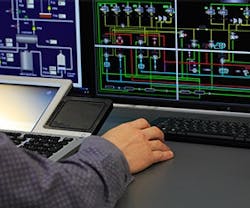Getting your lighting and HVAC systems to speak to each other can be more difficult than it sounds. The two systems speak different languages and many older automation and management products can control only one system, introducing an extra layer of complexity to bridging the two.
However, smart building control packages are increasingly allowing FMs to tie together lighting, HVAC and more by acting as an intermediary between disparate systems and control languages. If you’re considering an upgrade to manage multiple building systems, consider these tips.
1) Know Your Needs
Before comparing integration solutions, understand what you have in your building and what you need in a new system. If you have existing control systems for lighting and HVAC that simply don’t communicate with each other, you may simply need some integration devices and programming to connect the two systems, says Matt DeLoge, Vice President of Business Development and Technology for Johnson Controls. An older building with no automation or control infrastructure will require individual sensors and device controls in addition to the larger management system.
DeLoge recommends asking yourself a minimum of five questions before discussing lighting and HVAC integration products with vendors:
- What sequences of operation are you trying to achieve?
- What information do you need to obtain from each building system (occupancy, etc.) and where will you get it from?
- What devices will you control and what type of signal is required to have that control?
- How will the system communicate to all of the components? Communication devices have limitations and can only talk to so many other devices.
- How will each controller be programmed so it knows its role and responsibility in the broader integrated system?
2) Envision the End Result
It may be helpful to start at the end and work backward by determining what end result you want and then figuring out how to get there.
“Have the end in mind before making any hardware-related decisions,” advises DeLoge. “Having vague specifications can prevent the client from getting what they wanted at the best price.”
This advice also applies to lifetime costs, DeLoge says, as you’ll likely have your integrated system for years. Estimate how much you’ll spend (and save) with the integrated system compared to maintaining the status quo. “Think past the first cost,” DeLoge adds. “Many systems today have much longer lifespans than older, similar systems. That being said, the performance of many components may not be the same in later years as it was fresh out of the box.”
3) Understand the Challenges
The age of your existing systems can be a big hurdle, DeLoge says, as can the compatibility of the existing systems.
“If you have ever tried to program your TV, stereo, DVD player and other devices of different brands into one remote, you can understand the complexities of combining systems that speak different languages and are built using different standards,” DeLoge explains. “Look for design and integration services that will help you get the most out of your investment.”
Janelle Penny [email protected] is senior editor of BUILDINGS.
About the Author
Janelle Penny
Editor-in-Chief at BUILDINGS
Janelle Penny has been with BUILDINGS since 2010. She is a two-time FOLIO: Eddie award winner who aims to deliver practical, actionable content for building owners and facilities professionals.

